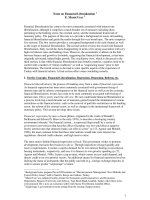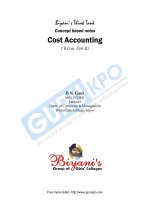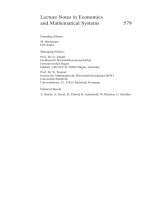M2 o1 notes
Bạn đang xem bản rút gọn của tài liệu. Xem và tải ngay bản đầy đủ của tài liệu tại đây (6.29 MB, 33 trang )
Welcome to Module 2 of the Elliott Wave Vertical. This is on Impulsive Patterns.
1
By now, we have completed Module 1 Elliott Basics and learned about:
Foundation of Elliott Wave Theory
Basic Wave Patterns
Wave Characteristics
Introduction to Mathematical Applications
Three Essential Rules, and the
Labeling of Waves
In this learning object, we will now break down the basics and focus on more
specifics of the wave structures, starting with:
Impulsive Wave Structures
Impulse and Diagonal Wave Characteristics, and the
Rules and Guidelines of Impulsive Waves
2
“I never did a day's work in my life. It was all fun,” says Thomas A. Edison, inventor.
Picture yourself learning all there is to know about impulsive patterns so that high
probability trades become apparent. And have fun at the same time, just like
Thomas Edison did!
3
4
5
Elliott Waves are fractal with waves embedded within waves, within waves, within
waves, etc.
Waves of any degree in any series are made up of waves of a lesser degree.
As such, this impulsive wave structure could easily be a 15-minute, hourly, daily, or
weekly chart. The structure is the same in any time frame.
6
Since waves are self-similar, this rising wave can be a wave 1, 3 or 5 in a 5-wave
sequence. These are the impulsive waves which move in the direction of the trend.
Each impulsive wave, once complete is followed by a corrective wave.
7
Now, you are beginning to see the repetitive nature of the waves that Elliott first
described, when he looked at the stock market as a fractal. The complete 8-wave
cycle, 1-2-3-4-5-A-B-C, is really 2 waves of a larger degree. We can look at it
another way as well. Looking at this sequence as waves 1 and 2, we can say that
waves of any degree in any series always subdivide into waves of a lesser degree.
Specifically, waves 1 and 2 of the daily chart will subdivide into waves of a lesser
degree which can be seen on the hourly chart.
8
In wave theory, this impulsive wave structure is called wave form. Whenever we
look at wave form, we start with the larger time frame and count the basic 5-wave
impulse move followed by a 3-wave corrective move, totaling 8 waves. Moving to a
shorter time frame, 5 waves turn into 21 waves and 3 waves into 13 waves. One
complete cycle has 8 waves, and subdividing further, the next cycle has 34 waves,
followed by 144 waves.
9
There are three types of impulsive waves:
Impulse
Leading Diagonal, and
Ending Diagonal
10
Impulses are the fundamental element of Elliott wave patterns and the most
common of the impulsive wave structures.
Impulses consist of 5 separate movements:
Wave 1 in the direction of the predominant trend.
Wave 2 as a retracement.
Wave 3 as a strong movement in the direction of the predominant trend.
Wave 4 as a retracement, and
Wave 5 as a final move toward the direction of the predominant trend.
Impulses move strongly in direction of trend.
As a guideline, a rising impulse will start at, or just after, a major low.
In a falling market, an inverted impulse will start at, or just after, a major high.
11
This is an example of an impulse wave, the fundamental 5-wave pattern.
Note the three rules which cannot be broken which we learned so far:
1) Wave 2 never retraces more than 100% of wave 1.
2) Wave 3 is never the shortest wave, and
3) Wave 4 does not enter into the same price territory as wave 1.
12
There are two other impulsive Elliott Wave patterns which move with the larger
trend.
They’re called Leading Diagonals and Ending Diagonals.
The Diagonal wave structure is different from the impulse wave structure.
While impulse patterns strongly move in the direction of the trend, diagonals move
more weakly in the direction of the trend.
Diagonals move within converging trend (or channel) lines.
In impulse structures, one of the rules is that wave 4 can never move into the price
territory of wave 1. Diagonals, in contrast, are a 5-wave structure where wave 4
always moves into the price territory of wave 1.
These diagonals are most common in highly leveraged markets such as Forex and
Commodities. Diagonal structures are also called Diagonal Triangles. Although
similar, Diagonal Triangles are different from Corrective Triangles, which we will
cover in Module 3: Corrective Patterns.
13
Ending Diagonals and Leading Diagonals have different characteristics and internal
structures.
-Ending diagonals are more common than leading diagonals
-The internal structure of an ending diagonal is comprised of all 3-wave or corrective
patterns
-That means that all of the waves of the 5th wave subdivide into 3 waves.
-Ending diagonals occur in the 5th wave position or the C position in an ABC
correction.
-In ending diagonals, wave 4 overlaps wave 1.
-Ending diagonals typically occur when the market is about to change direction.
-When it occurs in the wave 5 position, in higher degrees, a major reversal is
about to take place.(it slows down in anticipation of a change in direction)
-According to Elliott, it often occurs when the preceding move has gone “too
far too fast.”
-And in classical technical analysis, an ending diagonal is known as a rising
wedge. In the case of a downtrend, it is a falling wedge.
-The internal structure of a leading diagonal is comprised of 5-3-5-3-5 subwaves.
-The five sub-waves that make up a leading diagonal are a combination of
impulse and corrective wave patterns.
-Leading diagonals occur in the 1st wave position or in the A position in an ABC
correction.
-In leading diagonals, wave 4 also overlaps wave 1.
-Leading diagonals usually preceed a deep correction or retracement.
-Sometimes the diagonal triangle takes on an expanding shape, rather than a
wedge shape, where the boundary lines diverge. In a wedge shape, the boundary
lines converge.
14
In addition to a diagonal 5th wave, the 5th wave may end in what is called a
truncated wave 5. It is otherwise known as a failed 5th wave. This means that wave
5 fails to move beyond wave 3. The 5th wave still has the necessary 1-2-3-4-5
subwaves with a 5-3-5-3-5 internal structure and the rules still apply. However, it is a
short wave and usually signals a reversal pattern or a change in direction. In
classical technical analysis, a truncated 5th is a double top formation.
15
When the impulse wave seems to go on and on and on, it is called an
extension.
Extensions are elongated impulses with exaggerated subdivisions.
Extensions can appear in any one of the three impulse waves—1, 3, or 5.
However, wave 3 extensions are the most common, since it is usually the
strongest and the longest impulse wave of the three.
16
In this example, the 3rd wave extension is a 9 wave sequence. Within this 5-wave
sequence, wave 3 extends into another 5-wave sequence.
17
In this example, the 3rd wave has two extensions. This is known as a 3rd wave
extension of a 3rd wave extension. In other words, the extension occurs within an
extension. This extension is a 13-wave sequence. Within the initial 5-wave
sequence, wave 3 extends twice.
Notice that none of the 3 Elliott wave rules have been broken. Notice too, that in the
13-wave sequence, we have a series of 1-2 patterns. Specifically, we have a 1-2-12-1-2 pattern before continuing on.
Now the next question is, if wave 3 is extended, what does that tell you about the
length of wave 5? I can hear you saying, that it won’t be extended, and that is the
correct answer!
18
Now let’s look at wave 1 and wave 5 extensions. Waves 1 and 5 extensions also
occur in the form of 9-wave and 13-wave sequences as well. This example shows
9-wave sequences for the wave 1 and wave 5 extension. If wave 1 is extended, it is
likely that waves 3 and 5 will not be extended. And if wave 5 is extended, it is likely
that waves 1 and 3 were not extended.
19
In this example, waves 1 and 5 extensions occur as 13-wave sequences. The first
example is a 1st wave extension of a 1st wave extension. Note how the 5-wave
sequence seems to go on and on. The second example is a 5th wave extension of
a 5th wave extension. Wave 5 seems to go on and on. It is important to understand
extensions so as not to call the end of a 5-wave sequence prematurely.
20
This is an example of a wave extension in the EUR/USD hourly chart from June 5,
2006 to June 14, 2006. This is a 5-wave sequence that appears to go on and on.
When we look at it more closely, we see it as a series of extensions. In fact, we
notice that it is a third wave extension of a third wave extension, with 13 subwaves.
While one is trading this sequence, it is difficult to recognize the end of a 5-wave
sequence, especially if we are in extension mode. We will learn ways to recognize
the end of a trend further on in this course.
21
In this EUR/USD hourly chart from July 7, 2006 to July 19, 2006, you can see this
third wave extension of the third wave extension.
22
This is an example of a diagonal wave structure in the EUR/USD daily chart in
2006. This is an example of a leading diagonal triangle, an expanding triangle as
well. You can see the boundary lines diverge and you can see the overlap between
the wave 1 top and wave 4 bottom.
23
Here is an example of an ending diagonal triangle in the weekly USD/CAD from
August 2002 to May 2007. Notice that all of the legs appear to be 3 waves. Wave 3
is not the shortest wave. Wave 4 overlaps the end of wave 1. The ending diagonal,
although not complete at this time, will likely signal the trend reversal in the
USD/CAD. Notice the boundary lines converge as well.
24
And now for some rules and guidelines of impulse wave structures.
There are rules and there are guidelines.
First the rules:
1.
Impulse waves 1, 3, and 5 always subdivide into five waves.
2.
Wave 1 must be an impulse or a leading diagonal pattern.
3. Wave 2 never goes beyond the start of wave 1.
4. Wave 3 is never the shortest impulse wave.
5. Wave 3 must be an impulse.
6. Wave 4 never moves beyond the end of wave 1.
7. Wave 5 must be an impulse or an ending diagonal pattern, and
8. Waves 1, 3 and 5 can never all be extended.
And now for some guidelines:
1. Sometimes wave 5 does not move beyond the end of wave 3; this is called truncation.
2. Wave 5 often ends or slightly exceeds a trend line drawn off wave 3 parallel to a trend line drawn connecting the ends of
waves 2 and 4.
3. Wave 1, 3 or 5 is usually extended where the corrective waves are small compared to the impulse waves.
4. Wave 3 is usually the steepest and longest wave.
5. Usually either wave 3 or 5 is extended.
6. Wave 4 usually ends in the vicinity of sub-wave 4 of wave 3.
7. Fibonacci percentages are used to calculate retracements for waves 2 and 4, and
8. Fibonacci ratios are used to target the end of waves 3 and 5.
25









